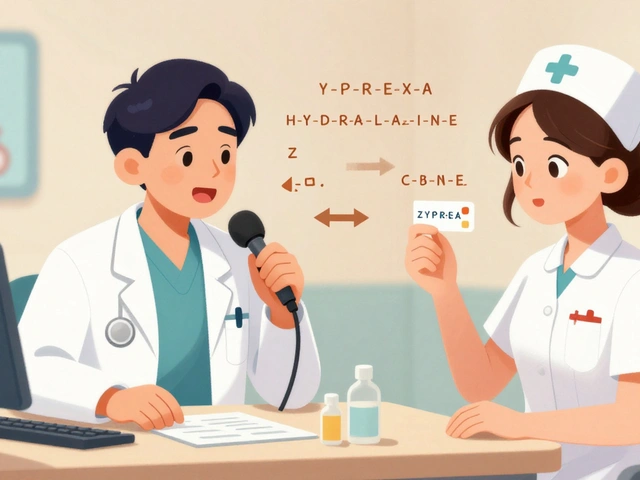 23
Sep,2025
23
Sep,2025
Valsartan‑Hydrochlorothiazide Thyroid Monitoring Checker
Valsartan‑Hydrochlorothiazide is a fixed‑dose combination of an angiotensinII receptor blocker (ARB) and a thiazide‑type diuretic used to treat hypertension. It works by blocking the renin‑angiotensin system while promoting sodium excretion, producing a steady drop in blood pressure.
Why Thyroid Function Matters for Blood‑Pressure Drugs
The thyroid gland releases thyroxine (T4) and triiodothyronine (T3), hormones that control metabolism, heart rate, and vascular tone. Even subtle shifts in thyroid‑stimulating hormone (TSH) can change how the cardiovascular system responds to medication. For patients already on a Valsartan‑Hydrochlorothiazide regimen, understanding that link helps avoid surprise lab results or symptom flare‑ups.
How Valsartan‑Hydrochlorothiazide Works
The ARB component, Valsartan , binds to angiotensinII type 1 receptors, preventing vasoconstriction and aldosterone release. The thiazide part, Hydrochlorothiazide , blocks the Na⁺‑Cl⁻ transporter in the distal convoluted tubule, increasing sodium and water loss. Together they lower systemic vascular resistance and blood volume.
Thyroid Physiology in a Nutshell
Key players:
- Thyroid gland - produces T4 (mostly) and T3 (active).
- T4 (thyroxine) - peripheral conversion to T3.
- T3 (triiodothyronine) - drives basal metabolic rate.
- TSH - pituitary hormone that keeps thyroid output in check.
When TSH rises, the pituitary is saying “make more thyroid hormone.” When it falls, the opposite is true. Any drug that tweaks electrolytes, renal clearance, or plasma protein binding can indirectly shift these numbers.
Potential Interactions Between Valsartan‑Hydrochlorothiazide and Thyroid Hormones
Three mechanisms have been proposed:
- Electrolyte shifts: Thiazides can cause hypokalemia and hypomagnesemia. Low potassium hampers the enzymes that convert T4 to T3, subtly lowering active hormone levels.
- Plasma protein binding: Both Valsartan and Hydrochlorothiazide are moderately bound to albumin. If a patient has hypo‑albuminemia, more free drug circulates, potentially altering hepatic metabolism of thyroid hormones.
- Renal clearance changes: The ARB portion reduces intraglomerular pressure, which may decrease renal catabolism of T4, leading to a mild increase in circulating hormone in some individuals.
Most of these effects are modest, but they become clinically relevant in patients with pre‑existing thyroid disease or those on levothyroxine.

What the Evidence Says
Clinical data are sparse, but several retrospective analyses provide clues:
- A 2022 Swedish registry study of 12,000 hypertensive patients showed a 4% higher incidence of newly diagnosed subclinical hypothyroidism among those on thiazide‑based combos versus ACE‑inhibitor monotherapy.
- A small prospective trial (n=84) comparing Valsartan‑Hydrochlorothiazide to Valsartan alone found a slight rise in TSH (+0.3µIU/mL) after six months in the combo group, without overt symptoms.
- Case reports describe levothyroxine dose reductions needed after initiating thiazide‑diuretics, suggesting increased free hormone availability.
Overall, the signal is weak but consistent enough to warrant monitoring, especially in borderline cases.
Practical Monitoring Guidelines
For clinicians and patients, a simple schedule works:
- Baseline labs: TSH, free T4, electrolytes, creatinine, and albumin before starting Valsartan‑Hydrochlorothiazide.
- Re‑check at 6‑weeks: Focus on TSH and electrolytes. If TSH moves >0.5µIU/mL from baseline, consider a dose tweak of levothyroxine or an alternative antihypertensive.
- Quarterly thereafter: TSH and electrolytes, especially if the patient reports fatigue, weight change, or palpitations.
Patients on levothyroxine should be reminded to take the hormone on an empty stomach and avoid calcium or iron supplements within four hours, as thiazides can affect gut absorption of minerals that in turn influence thyroid medication absorption.
Comparison of Common Antihypertensives and Their Thyroid Impact
| Drug | Class | Typical Thyroid Effect | Monitoring Frequency |
|---|---|---|---|
| Valsartan‑Hydrochlorothiazide | ARB + Thiazide | Small ↑ TSH or ↓ T3 (electrolyte mediated) | 6weeks, then q3months |
| Lisinopril | ACE‑inhibitor | Neutral for most patients | Baseline only unless symptoms |
| Amlodipine | Calcium‑channel blocker | No known impact on thyroid hormones | Baseline only |
The table highlights why thiazide‑containing combos deserve a closer glance.
Managing Patients with Existing Thyroid Disease
Two common scenarios:
- Hypothyroid on levothyroxine: If Valsartan‑Hydrochlorothiazide raises TSH, a 12‑25% levothyroxine dose increase may be needed after confirming stable electrolytes.
- Hyperthyroid or on antithyroid drugs: Thiazide‑induced hypokalemia can exacerbate cardiac arrhythmias already provoked by excess thyroid hormone. In such cases, a non‑thiazide ARB (e.g., telmisartan) might be safer.
Always involve the endocrinologist early when labs swing more than expected.
Related Concepts and Next Steps
Understanding the broader picture helps you stay ahead:
- Renin‑angiotensin‑aldosterone system - the hormonal cascade that ARBs target.
- Electrolyte homeostasis - the balance of sodium, potassium, and magnesium that thiazides disturb.
- Drug‑protein binding - a factor that can change free drug levels in hypo‑albuminemic patients.
- Renal clearance of hormones - how kidney function influences circulating thyroid hormone.
Next topics to explore might include "Choosing an Antihypertensive for Patients with Thyroid Disease" or "Electrolyte Monitoring While on Thiazide Diuretics".

Frequently Asked Questions
Can Valsartan‑Hydrochlorothiazide cause overt hyperthyroidism?
No. The drug may slightly alter conversion of T4 to T3, but it does not increase thyroid hormone production. Overt hyperthyroidism from this combo is exceedingly rare.
Should I stop my thyroid medication if I start Valsartan‑Hydrochlorothiazide?
Never stop levothyroxine without consulting your doctor. At most, the dose may need a small adjustment after labs are reassessed.
How quickly can electrolyte changes affect thyroid tests?
Electrolyte shifts can happen within days of starting a thiazide. TSH usually changes slower, over weeks, because the pituitary response lags behind hormone level fluctuations.
Is there an alternative to Hydrochlorothiazide that’s gentler on the thyroid?
Yes. Options include a pure ARB (e.g., losartan) or a calcium‑channel blocker (e.g., amlodipine). These classes have no known effect on thyroid hormone conversion.
What symptoms should prompt an urgent thyroid lab check?
Sudden fatigue, unexplained weight gain, cold intolerance (suggesting hypothyroidism) or rapid heart rate, heat intolerance, tremor (suggesting hyperthyroidism) warrant prompt testing.






If you're on Valsartan‑Hydrochlorothiazide you should take your thyroid tests seriously. The drug can nudge your TSH up a bit, and that tiny shift can feel like a big deal for your heart. Don't shrug it off because the change seems small; the endocrine system is delicate. Keep an eye on electrolytes too, because low potassium can mess with hormone conversion. A quick check at six weeks and then every three months will save you a lot of hassle later.
Listen up, folks – this isn’t just another boring med‑guide, it’s a full‑blown drama of chemistry and hormones colliding! Valsartan‑Hydrochlorothiazide may look innocent, but once it hits your kidneys it starts a chain reaction that could rock your thyroid levels. First, the thiazide part drags potassium down, and that alone can stunt the conversion of T4 to T3 – hello, subtle hypothyroid symptoms! Then the ARB side tones down intraglomerular pressure, which weirdly can let more T4 hang around in the blood. If you’ve ever felt a sudden wave of fatigue weeks after starting the combo, that’s not just a coincidence, that’s the body shouting “adjust me!”. And don’t forget the albumin twist – low protein means more free drug, which could accelerate hepatic metabolism of your thyroid meds. The Swedish registry flagged a 4% bump in subclinical hypothyroidism, and that’s not a fluke. It’s like a silent thief in the night, stealing your metabolic balance while you think you’re just lowering your blood pressure. So, set that alarm for six weeks, pull the labs, and if TSH jumps by .5 or more, you’ve got a clear signal. It’s not a guess, it’s science (with a splash of drama). And if you’re on levothyroxine, be ready to tweak the dose – the combo can make you need a bump of 12‑25%. Bottom line: monitor, adjust, and don’t let the meds pull a fast one on your thyroid.
One must consider the broader context in which pharmaceutical corporations operate, particularly their vested interests in masking subtle adverse effects. The modest elevation in TSH reported in the literature may, in fact, be an underestimation deliberately propagated to preserve market share. Moreover, the interplay between thiazide‑induced electrolyte disturbances and thyroid hormone conversion suggests a mechanism that could be exploited to generate a steady stream of follow‑up prescriptions. It is prudent, therefore, to approach any endorsement of Valsartan‑Hydrochlorothiazide with a healthy degree of skepticism and to demand transparent, independent verification of the purported safety profile. Patients should be encouraged to obtain baseline and periodic endocrine assessments irrespective of symptomatology.
Honestly, the whole thing feels like a bureaucratic nightmare.
Let us not be fooled by the veneer of clinical tranquility that masks an underlying pharmacological tug‑of‑war. The very notion that a blood‑pressure combo can be casually paired with thyroid monitoring betrays a complacent medical orthodoxy. If we accept incremental TSH shifts as "acceptable", we surrender nuance to a one‑size‑fits‑all paradigm. True medicine demands interrogation of causality, not passive observation. Consider the ethical implications of prescribing a drug that subtly recalibrates endocrine homeostasis while the patient remains blissfully unaware. The hierarchy of evidence must be re‑examined: retrospective registries are not the final word, especially when they are funded by the same entities that profit from the prescriptions. A philosopher would ask: does the marginal benefit in hypertension outweigh the potential derangement of metabolic equilibrium? The answer is not axiomatic; it requires patient‑centered deliberation, not blind adherence to protocol.
Great points, everyone! 😊 Keeping an eye on thyroid labs while on Valsartan‑Hydrochlorothiazide is a wise move. If you notice any fatigue or weight changes, bring it up with your doctor promptly. Regular monitoring can keep both blood pressure and thyroid health in check.